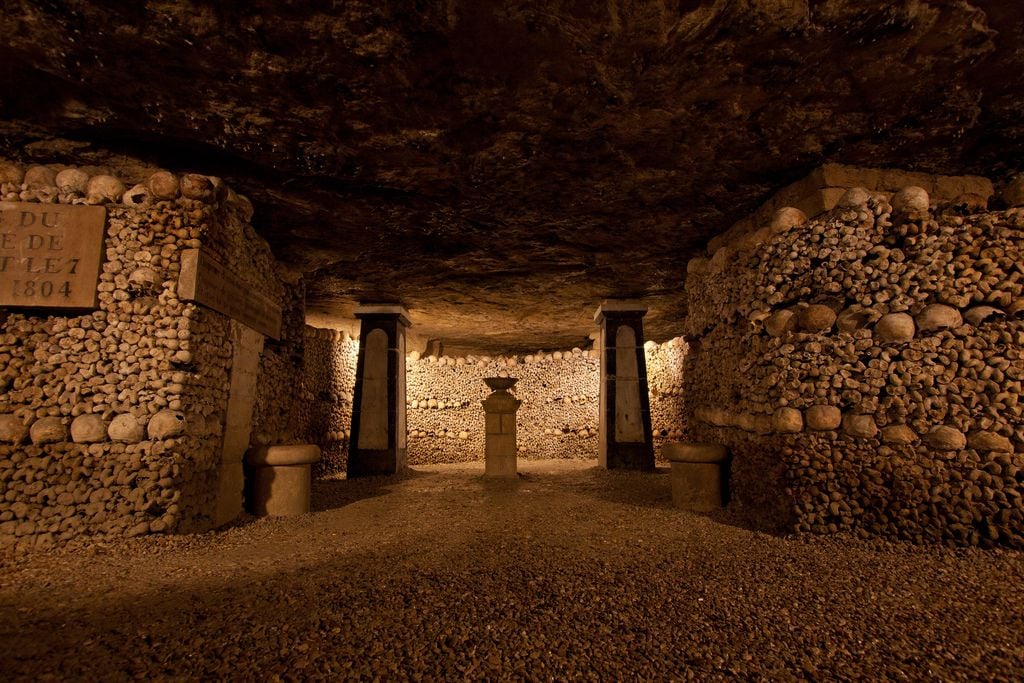Beneath Paris’ City Streets, There’s an Empire of Death Waiting for Tourists
More than 200 miles of tunnels sit just under the City of Lights—some lined to the ceiling with skulls and bones
As Paris grew into its a role as a major European hub, it eventually ran into a major problem: by the 17th century, enough people had lived and died in Paris that its cemeteries were overflowing, overstuffed with graves to the point when corpses, at times became uncovered. And so the solution arose to place them in the centuries-old tunnels that had existed beneath the streets of Paris since the 13th century, remnants of a time when limestone quarries were mined to build Paris into a thriving city. By the time these burials ended, 6 million Parisians' bones came to their final resting place in the city's catacombs.
Those living in the Les Halles neighborhood near Les Innocents, the city's oldest and largest cemetery were among the first to complain, reporting the cemetery exuded a strong smell of decomposing flesh—even perfume stores claimed they couldn't do business because of the off-putting smell. In 1763, Louis XV issued an edict banning all burials from occurring inside the capital, but because of Church pushback, which didn't want cemeteries disturbed or moved, nothing else was done. Louis XVI, Louis XV's successor, continued the crusade, also proclaiming that all cemeteries should be moved outside of Paris. It wasn't until 1780, however, that anything was done. That year, a prolonged period of spring rain caused a wall around Les Innocents to collapse, spilling rotting corpses into a neighboring property. The city needed a better place to put its dead.
So it went to the tunnels, moving bones from the cemeteries five stories underground into Paris' former quarries. Cemeteries began to be emptied in 1786, beginning with Les Innocents. It took the city 12 years to move all the bones—from bodies numbering between 6 and 7 million—into the catacombs. Some of the oldest date back as far as the Merovingian era, more than 1,200 years ago.
Beginning during the French Revolution, the dead were buried directly in the catacomb's ossuaries. Some famous (or infamous) characters from history who call the catacombs their final resting place include Jean-Paul Marat, one of the Revolution's most radical voices, and Maximilien de Robespierre, an influential figure during both the Revolution and the subsequent Reign of Terror. The city stopped moving bones into the ossuaries in 1860.
Today, a little more than a mile of the catacombs is open for visitors to explore. The public entrance is located in Paris' 14th arrodissement, at 1, avenue du Colonel Henri Rol-Tanguy. It takes about 45 minutes to walk through. Guides are available, but not required—visitors can also purchase audio guides, for 3 euros (about $4). The tunnels extend many more miles under the city, but it's illegal to visit most areas.
Before the entrance to the ossuary, there's an underground space used for themed exhibitions (2014's exhibit deals with Paris' geological history as an ancient sea). As visitors pass into the ossuary, they walk under a doorway with a haunting inscription above: "Arrête, c'est ici l'empire de la mort!" (Stop! This is the empire of death!). Inside the ossuary, bones are grouped by the cemeteries that they came from. Some are neatly stacked along the corridors; others arranged in patterns, creating crosses and other images. Visitors can also see sculptures in the Port-Mahon corridor created by a quarryman, and veteran of Louis XV's army, years before the bodies moved in. The main sculpture is a model of the fortress of Port-Mahon, a large island town where the creator, "Décure," is believed to have been held prisoner by the English during the Seven Years War.
The tunnels are open from 10 a.m. to 5 p.m. Tuesday through Sunday, and cost around $11 for adults. Be sure to bring a jacket—the tunnels are chilly, with a constant temperature of 57° F.
/https://tf-cmsv2-smithsonianmag-media.s3.amazonaws.com/accounts/headshot/natasha-geiling-240.jpg)

/https://tf-cmsv2-smithsonianmag-media.s3.amazonaws.com/filer/36/fb/36fbfa73-3a81-4199-83ab-5bac3aa0da85/5048869957_d13121de67_b.jpg)
/https://tf-cmsv2-smithsonianmag-media.s3.amazonaws.com/filer/15/ca/15ca0756-7735-4d3a-bc48-44d499a7079f/2524723158_2fee2198b5_b.jpg)
/https://tf-cmsv2-smithsonianmag-media.s3.amazonaws.com/filer/6a/45/6a45ef20-4391-4525-9093-76dc205f0ad7/plan_cata_paris_1857_jms.jpg)
/https://tf-cmsv2-smithsonianmag-media.s3.amazonaws.com/filer/e0/aa/e0aa5365-d1b0-4fe7-87ac-328a8f51eff4/6680979439_e0592ebd9b_b.jpg)
/https://tf-cmsv2-smithsonianmag-media.s3.amazonaws.com/filer/23/b0/23b071eb-d96c-4a78-b902-84f402e9d44b/5565931160_9ef0c1b005_b.jpg)
/https://tf-cmsv2-smithsonianmag-media.s3.amazonaws.com/filer/f0/74/f0748541-0601-4ec7-a2fc-5f5d1e2e91ed/3388727686_379a68bc09_b.jpg)
/https://tf-cmsv2-smithsonianmag-media.s3.amazonaws.com/filer/2a/76/2a761244-3d8c-40b9-9f44-f05317b6fafa/3687260571_547b0736c7_b.jpg)
/https://tf-cmsv2-smithsonianmag-media.s3.amazonaws.com/filer/54/ed/54ed606f-eb97-4dab-8dcc-70eb7a0d53a2/1996844585_d112b715da_b.jpg)
/https://tf-cmsv2-smithsonianmag-media.s3.amazonaws.com/filer/a5/5b/a55baea7-3555-4649-b36a-c4027116becc/5598996103_4dba14c618_b.jpg)
/https://tf-cmsv2-smithsonianmag-media.s3.amazonaws.com/accounts/headshot/natasha-geiling-240.jpg)